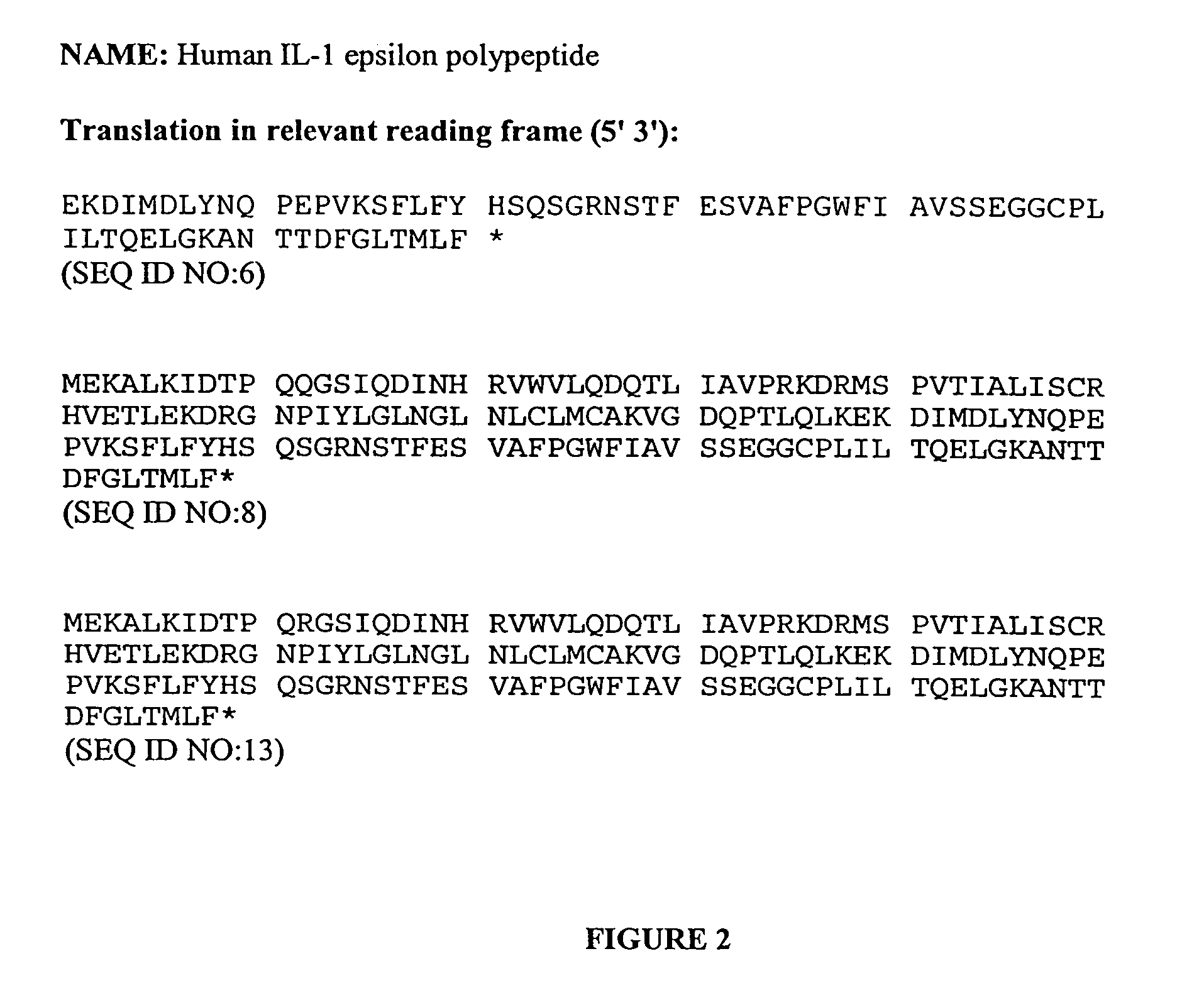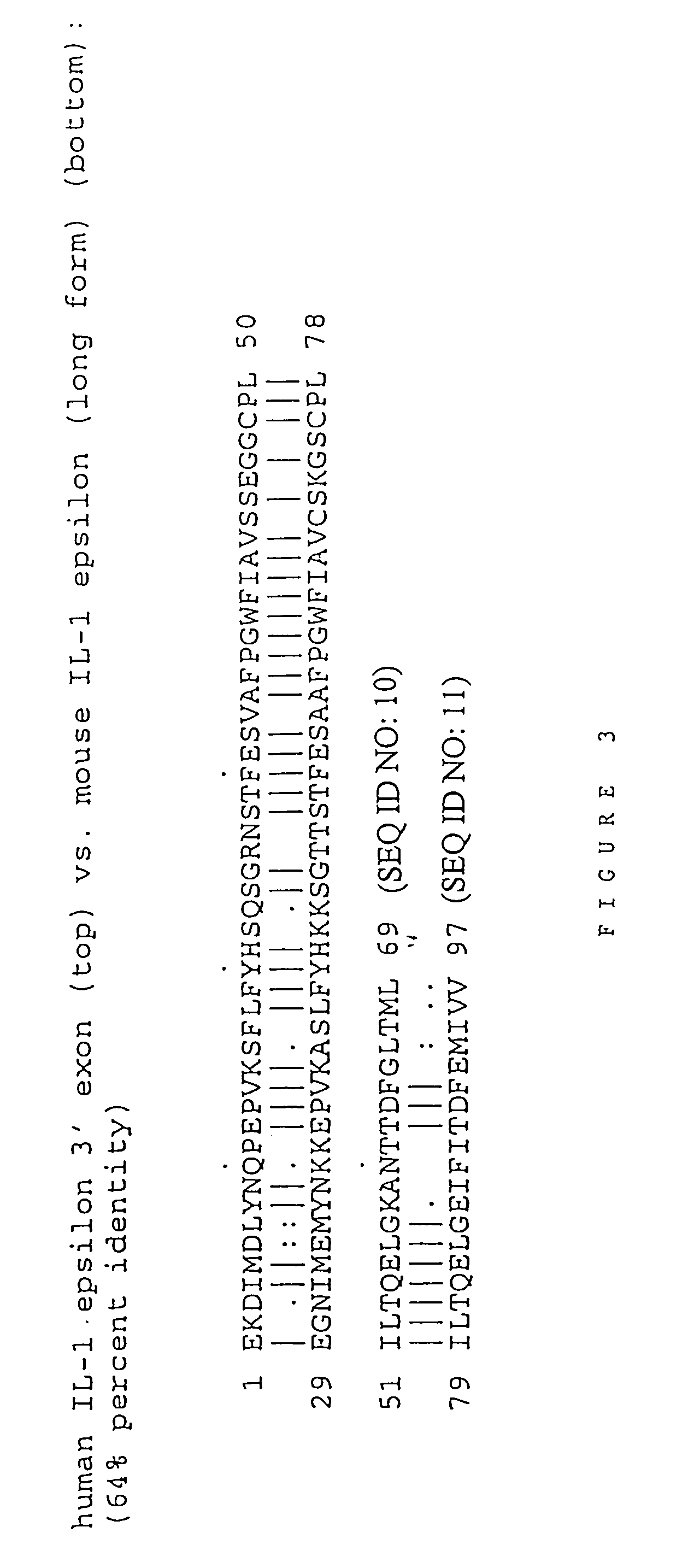Methods of treating inflammatory and/or autoimmune disease
a technology of inflammatory and/or autoimmune diseases, applied in the direction of antibody medical ingredients, peptide/protein ingredients, drug compositions, etc., can solve the problems of high concentration of il-1, severe tissue damage, shock, death,
- Summary
- Abstract
- Description
- Claims
- Application Information
AI Technical Summary
Problems solved by technology
Method used
Image
Examples
example i
Isolation and Identification of a New Human IL-1 Ligand
[0157]We screened a human genomic phage library (Stratagene catalog # 946205) using a mixture of 32P-labeled single-strand DNA probes corresponding to the entire coding sequence of murine IL-1 epsilon. After low stringency washing (low stringency washing is defined as 0.2×SSC / 0.1% SDS, at room temperature, Ausubel et al. Current Protocols in Molecular Biology, Vol. 2, p. 10.3, John Wiley & Sons, Inc., (1996)), a positive clone with a strong hybridization signal was identified. DNA made from this clone and subjected to Southern analysis identified a 5.5 kb Sal I-Asp 718 restriction fragment which was subcloned into pBluescript and sequenced. Homology analysis of the 5.5 kb fragment using the UWGCG computer program “bestfit” revealed that a 212 bp region within the clone was 74% similar at the nucleotide level to the 3 prime exon of murine IL-1 epsilon. As set forth in FIG. 3, this 212 bp sequence contains an open reading frame of...
example ii
Chromosome Mapping of Human IL-1 Epsilon by Radiation Hybrid Mapping
[0159]PCR was performed using the Whitehead Institute / MIT Center for Genome Research Genebridge4 panel of 93 radiation the Whitehead Institute / MIT Center for Genome Research Genebridge4 panel of 93 radiation hybrids which can be found by navigating to the Whitehead Institute / MIT website (www-genome.wi.mit, with an ‘edu’ extension), searching the site for genebridge4. Primers were used which lie within the putative 3 prime exon of human IL-1 epsilon and which amplify a 195 bp, product from human genomic DNA, but do not amplify hamster genoniic DNA. The results of the PCRs were converted into a data vector that was submitted to the Whitehead / MIT Radiation Mapping site on the internet (www-seq.wi.mit, with an ‘edu’ extension). The data was scored and the chromosomal assignment and placement relative to known Sequence Tag Site (STS) markers on the radiation hybrid map provided. According to die results, human IL-1 epsil...
example iii
Activation of Signaling Molecules in Human Cells by Human IL-1 Epsilon
[0160]The following describes tests and results that were carried out to determine whether Il-1 epsilon is capable of activating some of the same signaling molecules involved in stress responses as are activated by IL-1 alpha, IL-1 beta and other inflammatory cytokines.
[0161]Human IL-1 epsilon was transfected into COS-1 cells. Several days after the transfection, conditioned medium (containing the transiently expressed IL-1 epsilon) was harvested. Test cells were incubated with this conditioned medium, or alternatively with conditioned medium from COS-1 cells transfected with the empty expression vector. Approximately 10 minutes following the incubation, cell extracts were prepared from the test cells, and the presence of activated signaling molecules was assayed by the use of antibodies specific for the phosphorylated forms of IKBalpha (phosphorylation on Ser32), p38 MAP kinase (phosphorylation on Thr180 and Tyr1...
PUM
| Property | Measurement | Unit |
|---|---|---|
| pH | aaaaa | aaaaa |
| pH | aaaaa | aaaaa |
| concentrations | aaaaa | aaaaa |
Abstract
Description
Claims
Application Information
 Login to View More
Login to View More - R&D
- Intellectual Property
- Life Sciences
- Materials
- Tech Scout
- Unparalleled Data Quality
- Higher Quality Content
- 60% Fewer Hallucinations
Browse by: Latest US Patents, China's latest patents, Technical Efficacy Thesaurus, Application Domain, Technology Topic, Popular Technical Reports.
© 2025 PatSnap. All rights reserved.Legal|Privacy policy|Modern Slavery Act Transparency Statement|Sitemap|About US| Contact US: help@patsnap.com



